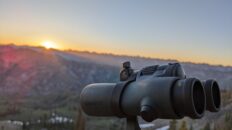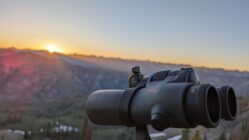If you’ve ever hunted Pronghorn over water, you know the importance of a good blind setup. There are many things to consider when selecting the location and positioning of the blind. After several years of success and failures, I’ve put together some tips that I believe can greatly increase your chance at success.

#1 Water Hole Selection
Just because you are seeing Pronghorn around a curtain area doesn’t mean that they are going to water near that location. Pick a spot that has sign around the water source. Look for tracks and droppings near the water. I’ll usually spend an entire day searching for areas that have the most tracks into the water. Pay special attention to incoming game trails, as this will give you an idea on where to position the blind for a broadside shot. For the most part, Pronghorn come into water and leave extremely fast, so shot opportunities are hard to come by. If there are no defined trails into the water, don’t panic, it just might take some time figuring out what direction they like to come in. As the days lead into the fall, most water holes begin to shrink, look for fresh tracks in the mud portion as they will be a good indicator that the pronghorn haven’t moved on to a different water source.

#2 Positioning The Blind
When it comes to positioning your blind I always try to set up for multiple shot opportunities. This will be dependent on the size of water that you’re hunting over. I usually try to have my max distance range around 50 yards or under. Pronghorn are extremely leery and have a tendency to jump the string as soon as you shoot. Keeping your shots in the 20-40 yard range will help your arrow get there fast enough before the Pronghorn can react. However, this all comes down to the size of water you’re hunting over. Sometimes you might just have to watch because of where they come in. As far as positioning your blind in an effort to keep the inside of the blind as dark as possible, don’t get hung up on this. I’ve set up multiple blinds keeping the sun’s direction in mind and honestly haven’t had a big enough difference to warrant which is better. The light on the blind is going to have a large contrast difference between the outside and the inside. If you have to position it directly into the sun, just be cautious when the sun is low. Once the sun is higher in the sky it seems to not matter.

#3 Make Adjustments
The most important thing I’ve learned from years of hunting over water, is you have to be willing to make adjustments. If the Pronghorn are coming in but stopping short of the water, it’s usually because of three things. #1 The Pronghorn are not used to the blind. By setting up the blind in advance, they will eventually get more comfortable and water. I’ve seen best results when my blinds are set up at least a week in advance but have also seen them feel more comfortable after just a few days. #2 Inside the blind needs to be blacked out. If you have too much light shining on the inside you will have to sit further back in the blind. Windows and zippers should be closed in the back. If they are open any movement from you will be seen from the front as you’re moving across both light sources. I’ve noticed by having a completely closed back wall, my success to get the Pronghorn closer, greatly increases. Avoid sitting near the front or peeking out the windows as much as possible. I will also black out my clothing. Ideally, wear a black long sleeve, have on a black hat and don’t wear anything that can cause glare, like sunglasses and watches. #3 The blind may be too close to the water’s edge. By moving your blind back off the water, the Pronghorn seem to respond better and feel safer. I’ve moved the blind just 10 yards further away and have seen a huge difference in where they will water. Don’t be afraid to make adjustments during the hunt. As long as you don’t move the blind to the opposite side of the water they’ll still feel comfortable.

#4 Brushing in the Blind
Blinds stand out especially in the desert. By using your surroundings and tucking the blind back to tall sagebrush or rocks, you can make the setup feel more natural. If this puts you too far from the water you can always add brush or grass to the outside of your blind. Spend the extra time before you sit to make your blind more camouflaged. I’ve gone back and forth on camouflaging the blind. Does it really work? From my observations it seems to help but I feel that setting up the blind prior to the hunt seems to be the biggest factor in having the most success.
Key Points
- Find sign around a water source.
- Setup the blind giving yourself a 50 yard maximum shot distance.
- Black out everything in the blind, including you.
- Make adjustments with the blind during the hunt
- Make your blind match your surroundings










